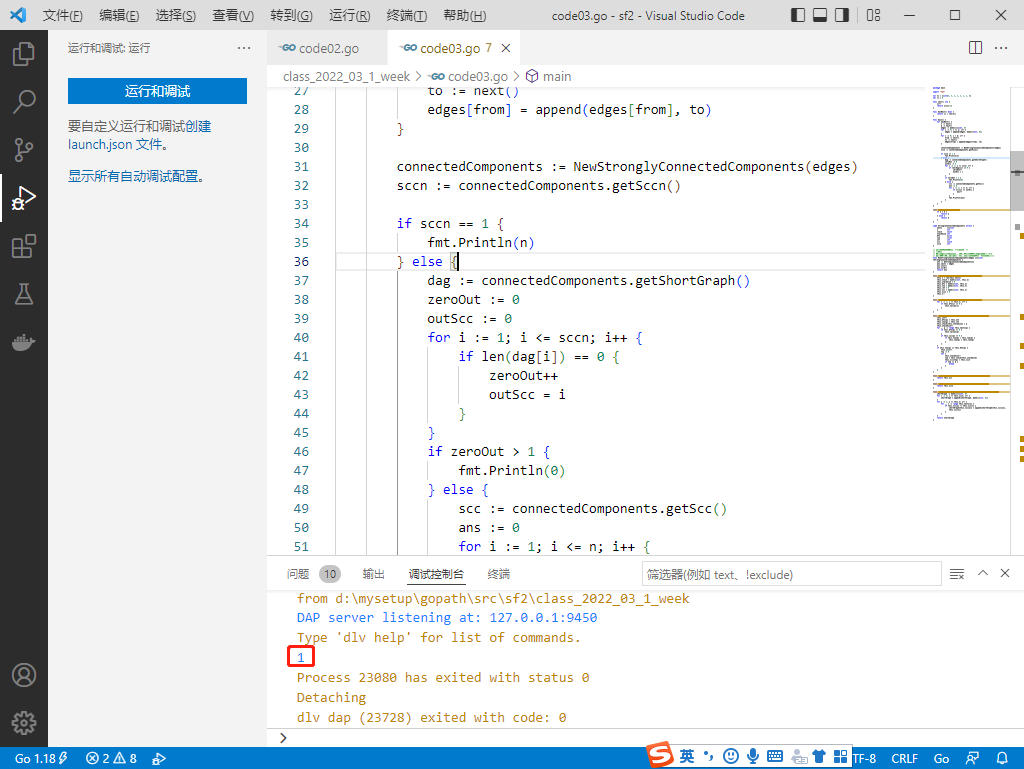2022-05-16:A -> B,表示A认为B是红人, A -> B -> C,表示A认为B是红人,B认为C是红人,规定“认为”关系有传递性,所以A也认为C是红人, 给定一张有向图,方式是给定M个有
2022-05-16:A -> B,表示A认为B是红人,
A -> B -> C,表示A认为B是红人,B认为C是红人,规定“认为”关系有传递性,所以A也认为C是红人,
给定一张有向图,方式是给定M个有序对(A, B),
(A, B)表示A认为B是红人,该关系具有传递性,
给定的有序对中可能包含(A, B)和(B, C),但不包含(A,C),
求被其他所有人认为是红人的总数。
测试链接 : http://poj.org/problem?id=2186,
注册一下 -> 页面上点击"submit" -> 语言选择java,
然后把如下代码粘贴进去, 把主类名改成"Main", 可以直接通过。
强连通分量练习题目。
答案2022-05-16:
tarjan算法。
出度为0的有两个或两个以上,不存在顶级大红人。
只有一个集体,那么这个集体有多少个元素就有多少个红人。
代码用golang编写。代码如下:
package main
import "fmt"
var sc = []int{3, 3, 1, 2, 2, 1, 2, 3}
var ii = 0
func next() int {
ii++
return sc[ii-1]
}
func hasNext() bool {
return ii < len(sc)
}
func main() {
for hasNext() {
n := next()
m := next()
edges := make([][]int, 0)
for i := 0; i <= n; i++ {
edges = append(edges, make([]int, 0))
}
for i := 0; i < m; i++ {
from := next()
to := next()
edges[from] = append(edges[from], to)
}
connectedComponents := NewStronglyConnectedComponents(edges)
sccn := connectedComponents.getSccn()
if sccn == 1 {
fmt.Println(n)
} else {
dag := connectedComponents.getShortGraph()
zeroOut := 0
outScc := 0
for i := 1; i <= sccn; i++ {
if len(dag[i]) == 0 {
zeroOut++
outScc = i
}
}
if zeroOut > 1 {
fmt.Println(0)
} else {
scc := connectedComponents.getScc()
ans := 0
for i := 1; i <= n; i++ {
if scc[i] == outScc {
ans++
}
}
fmt.Println(ans)
}
}
}
}
func getMax(a, b int) int {
if a > b {
return a
} else {
return b
}
}
type StronglyConnectedComponents struct {
nexts [][]int
n int
stack []int
stackSize int
dfn []int
low []int
cnt int
scc []int
sccn int
}
// 请保证点的编号从1开始,不从0开始
// 注意:
// 如果edges里有0、1、2...n这些点,那么容器edges的大小为n+1
// 但是0点是弃而不用的,所以1..n才是有效的点,所以有效大小是n
func NewStronglyConnectedComponents(edges [][]int) *StronglyConnectedComponents {
ans := &StronglyConnectedComponents{}
ans.nexts = edges
ans.init()
ans.scc0()
return ans
}
func (this *StronglyConnectedComponents) init() {
this.n = len(this.nexts)
this.stack = make([]int, this.n)
this.stackSize = 0
this.dfn = make([]int, this.n)
this.low = make([]int, this.n)
this.cnt = 0
this.scc = make([]int, this.n)
this.sccn = 0
this.n--
}
func (this *StronglyConnectedComponents) scc0() {
for i := 1; i <= this.n; i++ {
if this.dfn[i] == 0 {
this.tarjan(i)
}
}
}
func (this *StronglyConnectedComponents) tarjan(p int) {
this.cnt++
this.dfn[p] = this.cnt
this.low[p] = this.cnt
this.stack[this.stackSize] = p
this.stackSize++
for _, q := range this.nexts[p] {
if this.dfn[q] == 0 {
this.tarjan(q)
}
if this.scc[q] == 0 {
if this.low[p] > this.low[q] {
this.low[p] = this.low[q]
}
}
}
if this.low[p] == this.dfn[p] {
this.sccn++
top := 0
for {
this.stackSize--
top = this.stack[this.stackSize]
this.scc[top] = this.sccn
if top == p {
break
}
}
}
}
func (this *StronglyConnectedComponents) getScc() []int {
return this.scc
}
func (this *StronglyConnectedComponents) getSccn() int {
return this.sccn
}
func (this *StronglyConnectedComponents) getShortGraph() [][]int {
shortGraph := make([][]int, 0)
for i := 0; i <= this.sccn; i++ {
shortGraph = append(shortGraph, make([]int, 0))
}
for u := 1; u <= this.n; u++ {
for _, v := range this.nexts[u] {
if this.scc[u] != this.scc[v] {
shortGraph[this.scc[u]] = append(shortGraph[this.scc[u]], this.scc[v])
}
}
}
return shortGraph
}
执行结果如下:

公众号:福大大架构师每日一题


